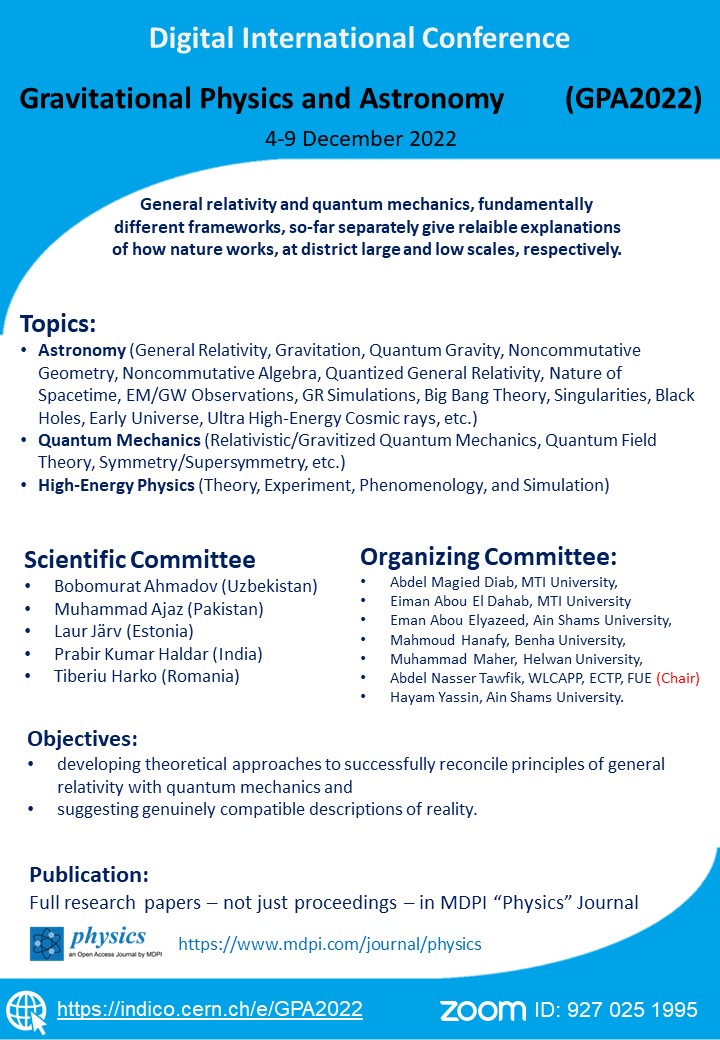Gravitational Physics and Astronomy 2022
Presentation Material:
All speakers are kindly advised to upload their presentations in pdf format prior to the announced time slots. We also recommend to upload video records.
- Please click "Call for Abstract". There you find a list of your submitted abstracts.
- Then you can click on an approved abstract to display its page.
- Although, this is no longer editable, you still able to follow the link "go to contribution", where you find a button to upload your file(s) as "presentation materials".

MDPI Physics Journal:
All invited contributions will be APC-waived if published in "Physics". While the journal welcomes high-quality submissions; meantime, it keeps the right to reject the invited papers if they are not qualified.
https://www.mdpi.com/journal/physics/special_issues/SPGPCC
- All approved talks shall be published as "full research papers" - not just proceedings - in a "special issue" of the MDPI open-access journal "Physics" https://www.mdpi.com/journal/physics - Scopus indexed and has CiteScore 2.2.
- For each submission, a single-blind peer-review process will be performed and at least two peer-review reports shall be collected.
- The guest editor, the conference organizer is responsible for making decisions as to whether a paper should be accepted or not after peer review and appropriate authors' revision.
- https://www.mdpi.com/journal/physics/special_issues/SPGPCC

https://www.mdpi.com/journal/physics

https://www.mdpi.com/journal/symmetry
Summary:
The ultimate objectives of this conference are to develop theoretical approaches to successfully reconcile principles of the general theory of relativity (GR) and quantum mechanics (QM). The general theory of relativity and the theory of quantum mechanics are fundamentally different frameworks that successfully separately deliver precise and reliable explanations of how Nature works. Accordingly, these obviously lead to genuinely incompatible descriptions of reality. The violation of the principles of relativity and equivalence, at quantum scales, belongs to the main conceptual difficulties of reconciling principles of quantum mechanics with general relativity so that their scales of applicability are entirely distinct. By the end of the day, this everlasting problem is not a trivial task that would be carried out by a few scholars. Its profound trans-disciplinary urges to unify the forces and skills of a huge global collaboration. The conference does not only aim at gathering experts but rather defining research directions. This is not limited to the narrow notion of quantizing GR or gravitizing QM. The entire spectrum of cosmology and high-energy physics either theoretical or phenomenological or computational shall be converted by the selected papers. This also includes all mathematical development contributing to quantizing GR and/or gravitizing QM.
We are witnessing a profound rapid change in our understanding of the phenomenon of Gravitation. We are exploring various implications of the general theory of relativity, and of its modified versions, in which gravitation is a consequence of the curvature of spacetime, and also various investigations into the mathematical foundations of the general theory of relativity, the nature of spacetime, and the imprints of quantum mechanics. We have been commissioning sophisticated high-energy experiments aiming at understanding the elementary particles that are the fundamental constituents of baryonic and leptonic matter and their underlying forces.
Conference Poster:

